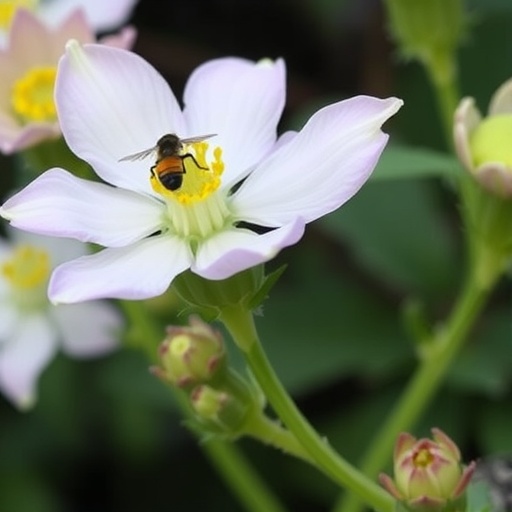In a fascinating exploration of ecology and botany, the recent study conducted by an accomplished team of researchers, including Silva, T.A.d., Fagundes, A.C.d.A., and Nascimento, G.Q.S.d.S., delves into the seasonal phenology and pollinator dynamics of two species of Hohenbergia, a genus within the Bromeliaceae family. The research is set against the backdrop of the Atlantic Forest, a biodiversity hotspot struggling under various environmental pressures. This exciting investigation is poised to shed light on the intricate relationships between flora and fauna in these fragmented ecosystems, revealing how changes in seasonal patterns might influence pollinator interactions.
Phenology—the study of the timing of life cycle events in organisms—emerges as a pivotal focus in the study of Hohenbergia. Understanding the phenological patterns of these bromeliads is critical for comprehending their reproductive strategies and ecological roles within their respective habitats. The researchers employed meticulous field observations to monitor blooming periods, fruiting phases, and overall plant health across different Atlantic Forest fragments. Each of these fragments presents a unique microclimate and biotic community, thus offering a rich field of study for the researchers.
Intriguingly, the study uncovers the striking diversity of pollinators associated with Hohenbergia species. The researchers documented various insect visitors, each contributing to the reproduction of these plants in distinct ways. By observing how different pollinators interact with Hohenbergia flowers, the team gained valuable insights into the preferences and behaviors of these insects. This aspect of the study not only enriches our understanding of plant-pollinator relationships but also poses critical questions about the impacts of habitat fragmentation and climate change on these interactions.
One of the study’s noteworthy aspects is its exploration of pollinator similarity between the two species of Hohenbergia. The researchers conducted comprehensive analyses to compare the floral traits of each species and their respective attractiveness to various pollinators. Differences in flower morphology, coloration, and scent were meticulously documented, providing a compelling narrative about evolutionary adaptation to specific pollinator guilds. This level of detail allows for a nuanced understanding of how ecological pressures can shape plant characteristics over time.
Moreover, the study does not shy away from addressing the broader implications of its findings. The rates of habitat loss and the ongoing challenges to biodiversity are stark realities that threaten both plant and animal species alike. By focusing on Hohenbergia in the Atlantic Forest, the researchers highlight how local conservation efforts must prioritize these unique ecosystems to preserve their intricate and often fragile relationships. The findings emphasize the need for holistic conservation strategies that consider the interconnectedness of species and their habitats.
As the researchers synthesized their data, they identified fascinating seasonal patterns in pollinator activity. Peaks in visitation rates were observed during specific times of the year, aligning with the blooming periods of Hohenbergia. Such synchronicity indicates a well-established ecological rhythm that both the plants and their pollinators rely upon. This seasonal dynamism raises further questions about how shifts in climate may disrupt these critical life cycles, potentially leading to mismatches between flowering times and pollinator availability.
The innovative use of technology in the study also deserves mention. The researchers utilized advanced imaging techniques to track visitor behavior and flower-pollinator interactions more accurately. These high-resolution digital tools allowed for capturing intricate details of pollinator movements, contributing significantly to the dataset’s robustness. The integration of technology in ecological research exemplifies a burgeoning trend that facilitates deeper investigation into complex biological relationships.
Furthermore, the researchers engaged with local communities throughout their investigation. They recognized the importance of traditional ecological knowledge and engaged with local stakeholders, sharing findings that could contribute to conservation strategies within these regions. This community-oriented approach is essential, as it fosters a sense of ownership and stewardship among local populations who directly interact with these ecosystems.
As the study contributes to the broader field of conservation biology, it also underscores the significance of continued research in ecological dynamics. The insights gained from studying Hohenbergia and its pollinators offer a microcosm of the complexities that define broader ecological networks. The team has set the stage for future investigations that can build upon their work, further illuminating the intricate dance between plants and their pollinators.
In examining the applicability of their findings, the study reveals potential implications for agricultural practices as well. The understanding of pollinator behavior and plant interactions can significantly inform best practices in agroecology, where fostering biodiversity can lead to more sustainable farming systems. This crossover between conservation ecology and agricultural research offers a promising dialogue that can drive innovation in food production and habitat protection.
Overall, this comprehensive study serves as a clarion call for the need to prioritize ecological research and conservation efforts in the face of ongoing environmental challenges. The research team’s dedication to understanding the sophisticated relationships within the Atlantic Forest ecosystem not only enriches academic discourse but also has real-world implications for conservation strategies around the globe.
In conclusion, the significance of the seasonal phenology and pollinator dynamics of Hohenbergia extends beyond mere academic interest. It embodies a blueprint for future research and conservation strategies aimed at preserving the delicate balance of ecosystems facing unprecedented pressure. The work of Silva, Fagundes, Nascimento, and their colleagues illustrates the profound interconnectedness of life and the urgent need to understand and protect our planet’s biodiversity.
Subject of Research: Seasonal phenology and pollinator dynamics of Hohenbergia species in the Atlantic Forest.
Article Title: Seasonal phenology and pollinator similarity of two species of Hohenbergia Schult. & Schult.f. (Bromelioideae: Bromeliaceae) in distinct Atlantic Forest fragments.
Article References: Silva, T.A.d., Fagundes, A.C.d.A., Nascimento, G.Q.S.d.S. et al. Seasonal phenology and pollinator similarity of two species of Hohenbergia Schult. & Schult.f. (Bromelioideae: Bromeliaceae) in distinct Atlantic Forest fragments. Sci Nat 112, 38 (2025). https://doi.org/10.1007/s00114-025-01992-2
Image Credits: AI Generated
DOI: https://doi.org/10.1007/s00114-025-01992-2
Keywords: Hohenbergia, seasonal phenology, pollinator dynamics, Atlantic Forest, biodiversity conservation.




